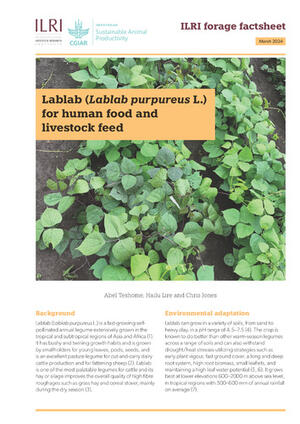
Sweet potato (Ipomoea batatas) vine silage: A cost-effective supplement for milk production in smallholder dairy-farming systems of East Africa?
Abstract
Context Dairy production in East Africa is dominated by smallholder production systems, but is dogged by suboptimal milk production mediated by poor nutrition. Grain-based concentrates can be used to make the energy and protein deficits in rain-fed systems, but this strategy faces several hurdles. For livestock production systems to be sustainable, it is important that less human-edible food is fed to animals and sweet potato can serve both as a source of human food (tuber) and animal feed (vines). Smallholder scale-appropriate technology has been used to allow feed preservation of the perishable sweet potato vines for use throughout the year. Aims We assessed the efficacy of sweet potato vine silage plus wheat bran (SPVSWB) as a supplement to maintain milk production at a lower cost than that of grain-based commercial dairy concentrate (CDC). Methods Multiparous Holstein–Friesian cattle (n = 12) were given a basal diet of Napier grass (Pennisetum purpureum cv. South Africa), ad libitum, plus a fixed amount of either SPVSWB or CDC, (designed to be both iso-nitrogenous and iso-caloric) during late (LL) and early (EL) lactations. Key results Daily milk yield was lower for SPVSWB than for CDC groups, although comparable (not significant), in both LL (6.2 vs 7.5 L/day) and EL (14.2 vs 16.0 L/day); however, the lower cost of production for SPVSWB (23.2 vs 48.7 KES/kg DM) ensured that margins on milk income over feed (per cow per day) were greater for SPVSWB in both periods. (LL: 71 vs 14.5; and EL: 426 vs 400 KES/day). The lower intake for SPVSWB than for CDC is most probably due to high neutral detergent fibre content in the supplement and the lower milk production, owing to either, or both, of lower energy and protein intake. Conclusions It is suggested that some reformulation of SPVS, replacing in part or in whole the Napier grass with rejected sweet potato tubers, will decrease the neutral detergent fibre content, increase the metabolisable energy content, reducing the need for additional wheat bran and may, thereby, enhance the production response to equate with that of CDC. Implications It is clear that, despite SPVSWB eliciting lower milk production (LL 6.2 and EL14.2 L/day) than does CDC (LL 7.5 and EL 16.0 L/day), SPVSWB is a cost-effective, accessible alternative to grain-based supplementation in small-holder dairy-farming systems of Kenya.
Citation
Gakige, J.K., Gachuri, C., Butterbach-bahl, K. and Goopy, J.P. 2020. Sweet potato (Ipomoea batatas) vine silage: A cost-effective supplement for milk production in smallholder dairy-farming systems of East Africa? Animal Production Science










